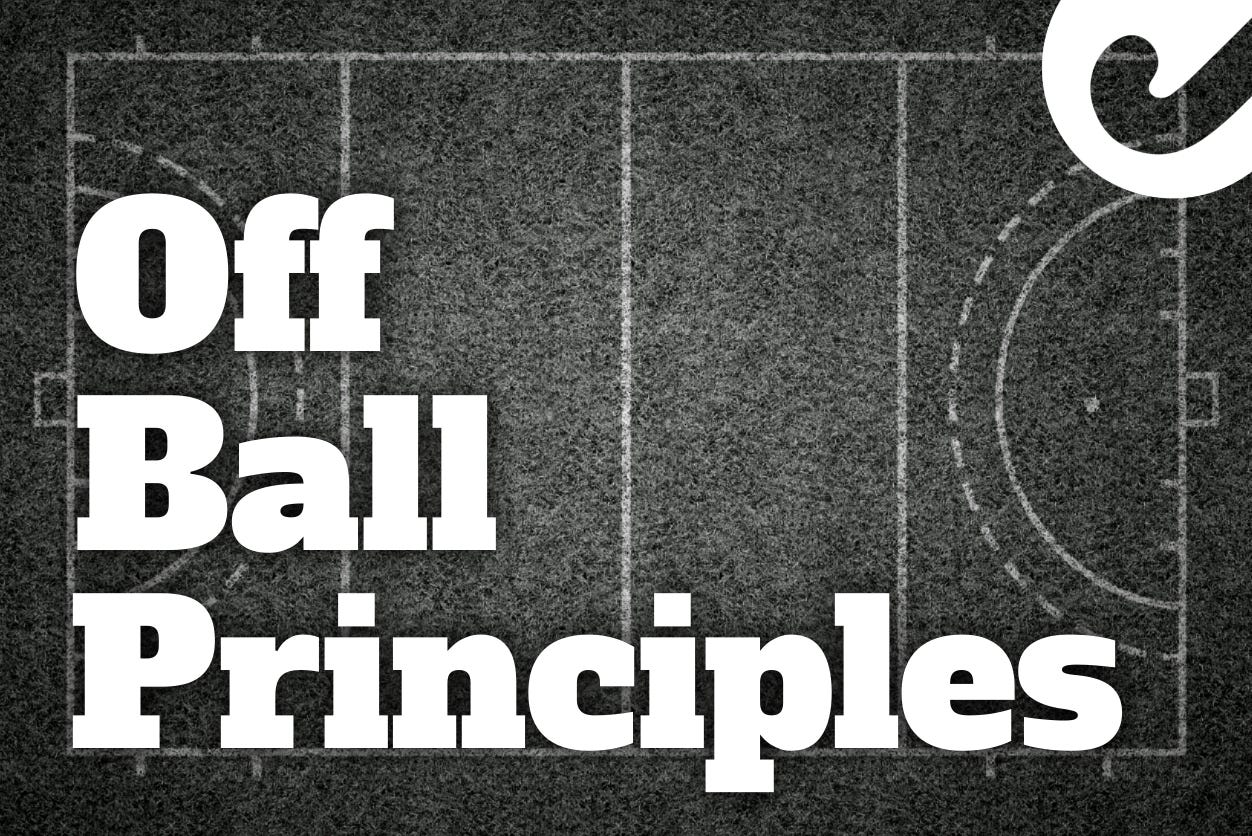Off Ball Principles
Off-ball principles, how to teach them to youth teams, how to reinforce them with experienced players, and how to manage them in teams with varying skill levels.
Off-ball principles are one of the most overlooked yet critical aspects of field hockey. While much of the focus in training often revolves around what players do with the ball—passing, dribbling, shooting—it’s important to remember that the majority of the game is played without it. As once pointed out during a masterclass with Ben Bishop:
“97% of the game is off-ball actions” .
This means that how players move, position themselves, and communicate when they don’t have possession can make or break a team’s performance.
TLDR;
Off-ball actions in field hockey are crucial and often neglected. The post outlines three pillars:
- positioning,
- movement, and
- communication;
And shows how to teach them to youth with simple cues and small-sided games, reinforce them for experienced players through video analysis and manage mixed-ability teams with pairing, differentiated feedback, and layered objectives.
👉 Celebrate off-ball work to build a cohesive, high-performing team.Sources:
→ https://my.thehockeysite.com/p/off-ball-skills
→ https://my.thehockeysite.com/p/9-yard-scoring
→ https://my.thehockeysite.com/p/small-sided-games It’s a good idea to explore the core off-ball principles, how to teach them to youth teams, how to reinforce them with experienced players, and how to manage them in teams with varying skill levels. Let’s dive in.
What Are Off-Ball Principles?
Off-ball principles are the guidelines that govern how players behave when they don’t have possession of the ball. These principles can be broken down into three main categories:
Positioning: Where should a player be in relation to the ball, their teammates, and the opposition? This includes concepts like maintaining defensive compactness, creating attacking width, and occupying dangerous spaces.
Movement: How should a player move to create opportunities or deny them? This includes leading runs, tracking back, and adjusting positioning based on the flow of the game.
Communication: How do players interact with each other to ensure cohesion? This includes verbal cues, hand signals, and even non-verbal understanding developed through familiarity.
Ben Bishop, in his masterclass on off-ball skills, emphasized that these principles are often what separate the best teams from the rest.
“It’s not just about where you are, but why you’re there and how you’re helping your team,” he said .
Teaching Off-Ball Principles to Youth Teams
For youth teams, the focus should be on building a strong foundation of understanding. These players are still developing their hockey IQ, so your approach needs to be simple, engaging, and age-appropriate.
1. Start with the Basics
Begin by introducing the core concepts of positioning, movement, and communication. Use simple language and relatable examples. For instance:
Positioning: “If you’re defending, stay between your player and the goal. If you’re attacking, find a space where you can receive the ball.”
Movement: “When you don’t have the ball, think about where you can go to help your team. Can you make space for a teammate? Can you get into a better position to receive a pass?”
Communication: “Talk to each other! Let your teammates know where you are and what you need.”
2. Use Small-Sided Games
Small-sided games are one of the best tools for teaching off-ball principles. Andreu Enrich, a big advocate for small-sided games, explained that they create realistic scenarios where players must make decisions under pressure. For example:
Play 3v3 or 4v4 games with specific rules, such as requiring a pass to a wide player before a goal can be scored. This encourages players to think about positioning and movement.
Use games where players can only score after completing a set number of passes. This forces them to focus on creating space and supporting each other.
3. Reinforce Through Repetition
Repetition is key to building habits. Design drills that repeatedly expose players to off-ball scenarios. For example:
A 2v2 drill where attackers must create space and defenders must stay compact.
A passing drill where players must constantly move to open spaces to receive the ball.
4. Celebrate Off-Ball Actions
Young players often focus on scoring goals or making flashy plays. As a coach, it’s your job to highlight and celebrate good off-ball actions. For example:
Praise a player for making a smart lead run, even if they don’t receive the ball.
Acknowledge a defender for cutting off a passing lane or tracking back to help.
Looking for some ideas on reinforcing these principles for experienced teams and teams with mixed-abilities?
Ask Assistant.Hockey or, if you’re a paid subscriber, read on for some suggestions ↓ Keep reading with a 7-day free trial
Subscribe to The Hockey Site to keep reading this post and get 7 days of free access to the full post archives.




